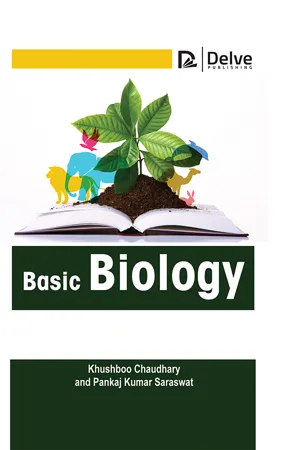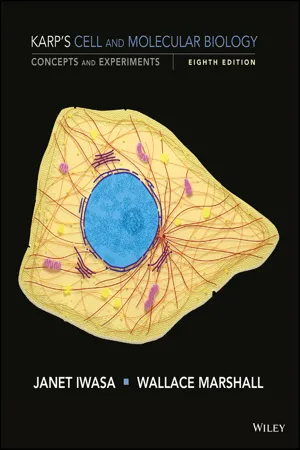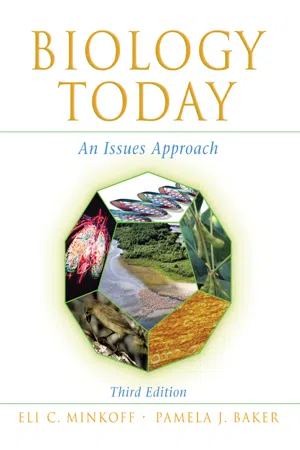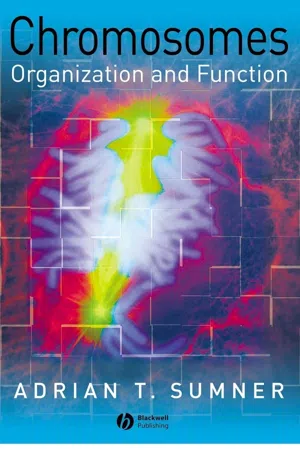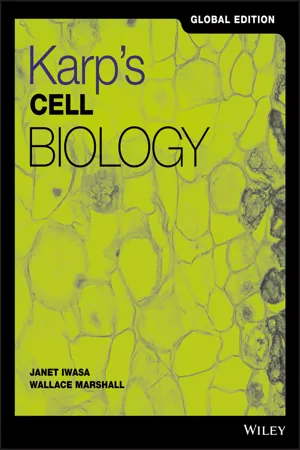Biological Sciences
Chromosomes
Chromosomes are thread-like structures found in the nucleus of a cell that carry genetic information in the form of genes. They are composed of DNA and proteins, and are visible during cell division. Humans typically have 46 chromosomes, with 23 pairs inherited from each parent. Chromosomes play a crucial role in the inheritance and transmission of genetic traits.
Written by Perlego with AI-assistance
Related key terms
1 of 5
9 Key excerpts on "Chromosomes"
- eBook - ePub
Medical Genetics E-Book
Medical Genetics E-Book
- Lynn B. Jorde, John C. Carey, Michael J. Bamshad(Authors)
- 2019(Publication Date)
- Elsevier(Publisher)
2Basic Cell Biology
Structure and Function of Genes and Chromosomes
All genetic diseases involve defects at the level of the cell. For this reason, one must understand basic cell biology to understand genetic disease. Errors can occur in the replication of genetic material or in the translation of genes into proteins. Such errors commonly produce single-gene disorders. In addition, errors that occur during cell division can lead to disorders involving entire Chromosomes. To provide the basis for understanding these errors and their consequences, this chapter focuses on the processes through which genes are replicated and translated into proteins, as well as the process of cell division.In the 19th century, microscopic studies of cells led scientists to suspect that the nucleus of the cell (Fig. 2.1 ) contains the important mechanisms of inheritance. They found that chromatin, the substance that gives the nucleus a granular appearance, is observable in the nuclei of nondividing cells. Just before a cell undergoes division, the chromatin condenses to form microscopically observable, threadlike structures called Chromosomes (from the Greek words for “colored bodies”). With the rediscovery of Mendel’s breeding experiments at the beginning of the 20th century, it soon became apparent that Chromosomes contain genes. Genes are transmitted from parent to offspring and are considered the basic unit of inheritance. It is through the transmission of genes that physical traits such as eye color are inherited in families. Diseases can also be transmitted through genetic inheritance.Fig. 2.1 The anatomy of the cell.From McCance KL, Huether SE. Pathophysiology: The Biologic Basis for Disease in Adults and Children . 8th ed. St. Louis: Elsevier Mosby; 2019.Physically, genes are composed of deoxyribonucleic acid (DNA). DNA provides the genetic blueprint for all proteins in the body. Thus genes ultimately influence all aspects of body structure and function. Humans are estimated to have approximately 21,000 genes (sequences of DNA that code for proteins). An error (or mutation - eBook - PDF
- Edward Bittar(Author)
- 1995(Publication Date)
- Elsevier Science(Publisher)
This is in conjunction with diffusible regulatory factors (proteins) and active enzymes such as RNA polymerases. More detailed understanding of chromatin and chromosome structure will be required to critically evaluate the roles they play in controlling transcription and, hence, normal differentiation and development. OVERVIEW DNA, the Hereditary Material, Is Folded Into Chromatin Results of many experiments culminating in the elucidation of its double-helical structure (Watson and Crick, 1953), established the role of DNA as the molecular carrier of genetic information. Although considerable progress has been made toward understanding how this information is stored, expressed, and transmitted from one generation to the next, a number of fundamental questions, pertaining to each of these processes, remain. The notion that chromatin (chromosome) structure, resulting from the interaction of DNA and proteins, plays an important role in these processes, is now widely accepted (Wolffe, 1992; Felsenfeld, 1992). The potential importance of chromatin structure may be particularly well-appreciated when one considers that a typical mammalian nucleus with a diameter of about 5 microns contains more than 2 m of DNA packed within. Chromatin Occurs in Many Forms, is Ordered and Dynamic Because of their distinctive morphology at the light microscopic level, condensed Chromosomes, both mitotic and meiotic, were the first recog- Figure 1. Chromosomes and chromatin. A, condensed Chromosomes within a mitotic Drosophila third instar larval neural ganglion cell. Mitotic Chromosomes, stained with orcein, are indicated by arrows. B, transmission electron micrograph of a Drosophila embryonic nucleus showing heterochromatin (H) and euchromatin (E) as indicated (micrograph courtesy of Dr. M. Berrios, Stony Brook). 57 58 NICO STUURMAN and PAUL A. FISHER nized forms of chromatin. - eBook - PDF
- Khushboo Chaudhary, Pankaj Kumar Saraswat(Authors)
- 2023(Publication Date)
- Delve Publishing(Publisher)
MOLECULAR BIOLOGY CHAPTER4 24. CHROMOSOME STRUCTURE: BASIC CHEMICAL ASPECTS – DNA, HISTONES AND NON-HISTONES; BASIC STRUCTURAL ASPECTS – THE NUCLEOSOMES, EUCHROMATIN AND HETEROCHROMATIN. Chromosomes It contains the genetic material such as DNA and RNA. Chromatin The chromosomal material in its decondensed and threadlike state. Mitosis It forms asexual reproduction. It occurs when an organism grows or replaces damaged cells. Prior to mitosis, a cell undergoes replication. The process in which chromatin is copied. It produces diploid cells. Basic Biology 176 Prophase Start of mitosis. The chromatin condenses into rod-like Chromosomes. Each chromosome is consists of sister chromatids, connected at the centromere and nuclear membrane disappears. Prophase Metaphase Chromosomes align themselves at the flat plane at the cell equator in metaphase. Molecular Biology 177 Metaphase Anaphase Centromeres are split. Sister chromatids-now Chromosomes- are pulled to the opposite poles of the cell. Anaphase Basic Biology 178 Telophase Chromosomes are unravel, returning the chromatin to its non-dividing thread-like state. Nuclear membrane is assembles. Telophase Cytokinesis Division of the cytoplasm in cytokinesis and it initiates during anaphase and telophase. Cytokinesis Differs in animals and plant cells. Plant cells form a cell plate. Membranous vesicles congregate at the center of the cell.Vesicles are contain cell wall material. Animal cells form a cleavage furrow. It forms around the periphery of the dividing cell. It furrow becomes deeper and deeper until membrane pinches off forming two cells. Molecular Biology 179 Chromosomes Come in Matched Pairs Homologous pairs: Chromosomes that are closely matched in size and shape. It determine the same traits. Sex Chromosomes: Those that determine the gender of the organism. - eBook - PDF
Karp's Cell and Molecular Biology
Concepts and Experiments
- Gerald Karp, Janet Iwasa, Wallace Marshall(Authors)
- 2016(Publication Date)
- Wiley(Publisher)
Over the following century, these hereditary factors were shown to reside on Chromosomes and to consist of DNA, a macromolecule with extraordinary properties. FIGURE 10.1 provides an overview of some of the early milestones along this remarkable journey of discovery, capped by the description of the double helical structure of DNA in 1953. In the decades that fol- lowed this turning point, a major branch of molecular biology began to focus on the genome, which is the collective body of genetic information that is present in a species. A genome contains all of the genes required to “build” a particular organism. During the past decade or so, collaborations by laboratories around the world have uncovered the complete nucleotide sequences of many different genomes, including that of our own species and the chimpanzee, our closest living relative. For the first time in human history, we have the means to reconstruct the genetic path of human evolution by comparing corresponding regions of the genome in related organ- isms. We can learn which regions of our genome have been dupli- cated and which have been lost since our split from a common ancestor; we can observe which nucleotides in a particular gene or regulatory region have undergone change and which have remained constant; most important, we can infer which parts of our genome have been subject to natural selection and which have been free to drift randomly as time has passed. We have also begun to use this information to learn more about our history as a species: when and where we arose, how we are related to one another, and how we came to occupy the regions of the Earth that we have. The science of genetics began in the 1860s with the work of Gregor Mendel, a friar at the abbey of St. Thomas located in today’ s Czech Republic. Mendel’s laboratory was a small garden plot on the grounds of the abbey. - eBook - PDF
Biology Today
An Issues Approach
- Eli Minkoff, Pamela Baker(Authors)
- 2003(Publication Date)
- Garland Science(Publisher)
Genes, Chromosomes, and DNA Issues Biological Concepts Chapter Outline • How have our concepts of genes developed? • What are the limitations of Mendelian genetics? • Does Mendelian genetics explain inheritance in all species? • What do we not understand about genes, Chromosomes and DNA? • The gene • Patterns of inheritance (trait, phenotype and genotype; sex determination; sex-linked traits) • Mitosis and meiosis • DNA (the genetic material, DNA structure, DNA replication) • Human genetic conditions Mendel Observed Phenotypes and Formed Hypotheses Traits of pea plants Genotype and phenotype The Chromosomal Basis of Inheritance Explains Mendel’s Hypotheses Mitosis Meiosis and sexual life cycles Gene linkage Confirmation of the chromosomal theory Genes Carried on Sex Chromosomes Determine Sex and Sex-linked Traits Sex determination Sex-linked traits Chromosomal variation Social and ethical issues regarding sex determination The Molecular Basis of Inheritance Further Explains Mendel’s Hypotheses DNA and genetic transformation The structure of DNA DNA replication 2 33 Genes, Chromosomes, and DNA 2 H ow do offspring come to resemble their parents physically? This is the major question posed by the field of biology called genetics, the study of inherited traits. Genetics begins with the unifying assumption that biological inheritance is carried by structures called genes. The discovery of what genes are and how they work has been the subject of many years of research. Genes are carried on Chromosomes and much has been learned about genetics from the study of Chromosomes. Among the earliest findings was the fact that the same basic patterns of inheritance apply to most organisms. The inheritance of some human traits, such as albinism, can be explained by hypotheses first formulated from the study of pea plants, whereas the inheritance of other human traits, such as sex determination, is a much more complicated affair. - eBook - PDF
- Gerald Karp, Janet Iwasa, Wallace Marshall(Authors)
- 2021(Publication Date)
- Wiley(Publisher)
434 CHAPTER 10 The Nature of the Gene and the Genome 10.1 The Concept of a Gene as a Unit of Inheritance Our concept of the gene has undergone a remarkable evolution as biologists have learned more and more about the nature of inheritance. The earliest studies revealed genes to be discrete factors that were retained throughout the life of an organism and then passed on to each of its progeny. Over the following century, these hereditary factors were shown to reside on chro- mosomes and to consist of DNA, a macromolecule with extraor- dinary properties. Figure 10.1 provides an overview of some of the early milestones along this remarkable journey of discov- ery, capped by the description of the double helical structure of DNA in 1953. In the decades that followed this turning point, a major branch of molecular biology began to focus on the genome, the collective body of genetic information that is pres- ent in a species. A genome contains all of the genes required to “build” a particular organism. During the past decade or so, col- laborations by laboratories around the world have uncovered the complete nucleotide sequences of many different genomes, including that of our own species and the chimpanzee, our clos- est living relative. For the first time in human history, we have the means to reconstruct the genetic path of human evolution by comparing the corresponding regions of the genome in related organisms. We can learn which regions of our genome have been duplicated and which have been lost since our split from a common ancestor; we can observe which nucleotides in a particular gene or regulatory region have undergone change and which have remained constant; most importantly, we can infer which parts of our genome have been subject to natural selection and which have been free to drift randomly as time has passed. - eBook - PDF
Chromosomes
Organization and Function
- Adrian T. Sumner(Author)
- 2008(Publication Date)
- Wiley-Blackwell(Publisher)
Larger scale movements are asso-ciated with changes in the functional state of the cells, however. Evidence for a higher level of organization of the Chromosomes in nuclei is also available, and indicates that this differs greatly between species. Certain Chromosomes, because of their function (or lack of it), lie in specific regions. Thus the inactive X chromosome in female mammals forms a compact structure – the Barr body – against the nuclear envelope (Fig. 5.2b). Chro-mosomes that bear nucleolus organizer regions (NORs; Chapter 11) are inevitably associated with the nucleolus if the NORs are active; in a species such as humans, with five pairs of chro-mosomes bearing NORs (not all of which are usually active, however), these Chromosomes are therefore closely associated with each other. Certain human Chromosomes seem to be more closely associated with each other in quiescent (non-cycling) nuclei than would be expected by chance (Nagele et al ., 1999), although the signifi-cance of such associations is far from clear. In human cells, it has been reported that the most gene-rich Chromosomes are nearer the centre of 58 Chapter 5 Figure 5.1 (a) Electron micrograph of a nucleus from a mammalian cell, showing condensed and dispersed chromatin and the nucleolus. Scale bar = 1 m m. (b) Electron micrograph of a portion of a nucleus, showing the double nuclear envelope and nuclear pores (arrows). Scale bar = 0.2 m m. (a) (b) The Chromosomes in interphase 59 Box 5.1 Fluorescence hybridization (FISH) in situ anti-digoxygenin, respectively (Fig. 1). Full pro-tocols for FISH are found in standard labora-tory manuals (e.g. Craig, 1999; Schwarzacher & Heslop-Harrison, 2000; Saunders & Jones, 2001). Fluorescence in situ hybridization (FISH) is the labelling of specific DNA sequences in situ (in Chromosomes or nuclei) with a fluorescently labelled complementary nucleic acid, so that the location of these sequences can be seen under a microscope. - eBook - PDF
- Gerald Karp, Janet Iwasa, Wallace Marshall(Authors)
- 2018(Publication Date)
- Wiley(Publisher)
In addition, these Chromosomes are not inert cellular objects but dynamic structures in which certain regions become “puffed out” at particular stages of development (Figure 4.8b). These chromosome puffs are sites where DNA is being tran- scribed at a very high level, providing one of the best systems available for the direct visualization of gene expression. 4.5 The Structure of DNA Classical geneticists uncovered the rules governing the transmis- sion of genetic characteristics and the relationship between genes and Chromosomes. In his acceptance speech for the Nobel Prize in 1934, T. H. Morgan stated, “At the level at which the genetic experiments lie, it does not make the slightest difference whether the gene is a hypothetical unit or whether the gene is a material particle.” By the 1940s, however, a new set of questions was being considered, foremost of which was, “What is the chemical nature of the gene?” The experiments answering this question are outlined in the Experimental Pathways, at the end of the chapter. Homologous chromosome pair (BbWw) (before meiosis) Gray body Black body Long wings Short wings Replication and crossing over Parental gamete (bw) Parental gamete (BW) Mate flies with homozygous recessive flies (bbww) BbWw bbWw bbww Bbww Homologous chromosome pair in tetrad formation Crossover gamete (Bw) Crossover gamete (bW) (b) (a) B b b b B B W w B w b w b W W B w w W W FIGURE 4.7 Crossing over provides the mechanism for reshuffling alleles between maternal and paternal Chromosomes. (a) Simplified representation of a single crossover in a Drosophila heterozygote (BbWw) at chromosome number 2 and the resulting gametes. If either of the crossover gametes participates in fertiliza- tion, the offspring will have a chromosome with a combination of alleles that was not present on a single chromosome in the cells of either parent. (b) Bivalent (tetrad) formation during meiosis, showing three crossover intersections (chiasmata, indicated by black arrows). - eBook - PDF
- Geoffrey Bourne(Author)
- 2012(Publication Date)
- Academic Press(Publisher)
Loops thus appear to be localized segments of the genetic material that may be responding to increased demands for genetic product by unfolding and making available as much DNA as 542 MONTROSE J. MOSES possible for the production of specific messenger. This is shown in a diagrammatic form in Fig. 26A. C. G IANT C HROMOSOMES The context of chromosome strandedness in which the giant chro-mosome has already been considered need not restrict the discussion to follow. Whether the basic chromosome strand of which the salivary gland chromosome of Drosophila, for example, is known to be a high multiple (1024 times) contains 1, 2, 4, or 8 DNA double helices is immaterial at the moment. The polytene Chromosomes of an individual are characterized by the pattern of bands and interbands arranged along their length (Fig. 25B). It is agreed that the band is equivalent to the chromomere of the univalent chromosome, and thus also to the chromomere of the lampbrush chromosome. Both bands and interbands contain DNA, the concentration merely being higher in the bands. The functional mor-phology of these Chromosomes, particularly with respect to the bands, has been summarized by Beermann (1956, 1959, 1963). It is generally conceded that bands are greatly folded up and com-pressed regions of continuous chromosome strands, while the interbands represent the stretched-out intervals. The former, rather than the latter, probably represent potential sites of genetic activity. When genes re-sponsible for phenotypic mutations are relegated to specific positions along the chromosome by recombination mapping, they fall in the band, rather than the interband, regions. However, a band cannot be a basic unit of recombination since it may contain a number of recombinants, even though these are related. Unrelated mutants are not localized in the same band.
Index pages curate the most relevant extracts from our library of academic textbooks. They’ve been created using an in-house natural language model (NLM), each adding context and meaning to key research topics.


